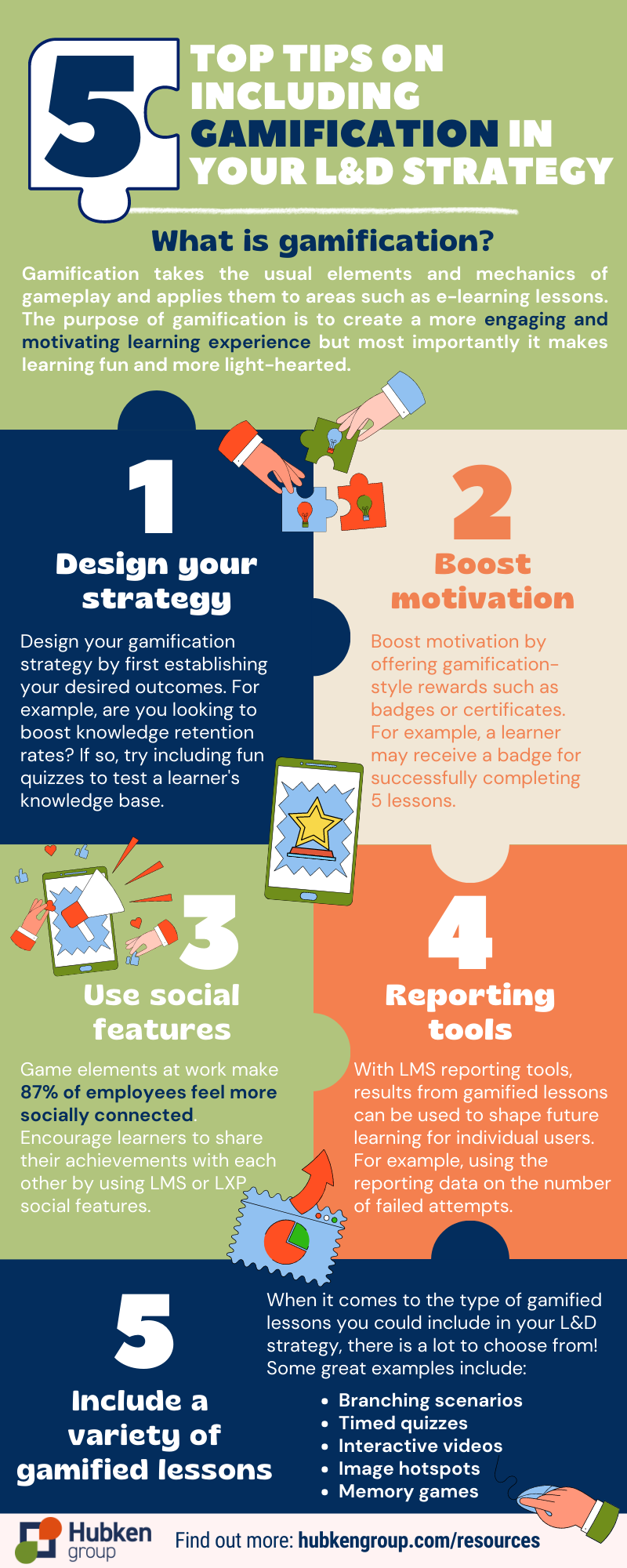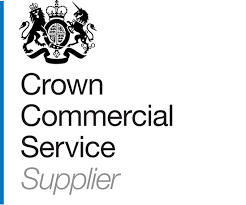How gamification boosts employee engagement and retention
Incorporating gamification elements such as points, badges, leaderboards, and progress tracking into training programmes creates a powerful boost to completion rates by making learning more engaging and rewarding. These features, combined with interactive challenges, meaningful rewards, and opportunities for social connection, work together to enhance both motivation and long-term knowledge retention.
By appealing to people's natural competitive instincts, their appreciation for recognition, and their satisfaction in achieving goals, gamification transforms passive learning into an active, enjoyable experience. This approach encourages learners to stay committed throughout their training journey and genuinely want to complete their modules, rather than viewing them as just another task to get through.
Gamification has quickly become one of the most effective ways to capture the attention of unengaged learners and motivate them by driving a sense of accomplishment through gamified e-learning achievements. Most organisations with a powerful e-learning platform such as a learning management system (LMS) will take advantage of its gamification features and functionality but it's worth noting that this should be done strategically in order to get the most out of the following gamified elements:
- Points, badges and leaderboards are all designed to not only provide a quantifiable measure of progress and success but also serve as a visual 'milestone' of achievement and foster friendly competition amongs team members
- Progress tracking is easy to see using visual progress bars and other indicators of success to provide a sense of accomplishment
- Interactive challenges and quizzes provide immediate feedback to keep learners engaged
- LMS features such as discussion forums, chat rooms and other forms of collaboration foster a sense fo community and encourage learners to interact with their peers.
- Incorporate real-world scenarios that allow learners to apply their knowledge in a practical setting
- Gathering feedback from learners about the gamified elements help to identify areas of improvement and to ensure training remains relevant and engaging
To help you get up to speed with how to go about including gamification in your L&D strategy, we've turned one of our popular gamification blogs into a handy infographic - keep scrolling to view it and be sure to keep reading for further insights on these top tips below.
What is gamification?
Gamification takes the usual elements and mechanics of gameplay and applies them to areas such as e-learning lessons. The purpose of gamification is to create a more engaging and motivating learning experience but most importantly it makes learning fun and more light-hearted.
Want to find out more about gamification? Visit our dedicated LMS functionality page.
1. Design your gamification strategy
Before you make the mistake of injecting gamified lessons into your L&D programmes at random, you need to establish your desired outcomes. Ask yourself, how would these gamified lessons benefit the learners, the business/organisation and the trainers/admins/managers? Once you have established what you are hoping to achieve by implementing a gamification strategy, you’ll be better placed to determine the type of gamified lessons you should include as well as the topic areas they would be best suited to.
For example, are you looking to boost knowledge retention rates? If so, your lessons may benefit from including fun quizzes to test the learner’s knowledge base. If you’re looking to encourage more teamwork and team bonding within your workforce, you can group employees together and create leaderboards to encourage employees to motivate each other to complete training and ensure knowledge is retained. You can use the results of gamified lessons and include them in a team scoreboard.

2. Boost motivation
One of the reasons L&D managers love to incorporate gamification into their e-learning programmes is that learners are more motivated to complete lessons. One of the drivers for motivation is simply because gamified lessons are more entertaining and enjoyable. You can also further boost motivation by offering rewards to those who complete lessons or demonstrate a good knowledge of content as a result of high scores or high pass rates on tests.
You can boost motivation by offering gamification-style rewards such as badges or certificates. For example, a learner may receive a badge for successfully completing 5 lessons or gaining full marks in an end-of-course assessment. Additionally, including progress indicators such as a progress bar or a percentage indicating the portion of the course that has been completed are also great ways to boost motivation and encourage learners to continue their learning.

3. Use social features
Gamification has the power to bring learners together and encourage better communication. In fact, studies show that game elements at work make 87% of employees feel more socially connected. In addition to leader boards and multiple-user gamified lessons, you can create a community using social features. Using an e-learning platform such as a learning experience platform (LXP), you can create discussion boards and forums. Within these, learners can discuss gamified lessons and share tips and knowledge to help each other progress.
Learners can also share their achievements online, celebrating their most recent certificates or badges. By using social features to share gamification rewards, users are given the platform to encourage others whilst likely feeling motivated by seeing the achievements of others and determined to complete lessons so they can do the same.
4. Use reporting tools
A robust e-learning platform such as Totara Learn will provide readily available reports and analytics for trainers/teachers/admins to use. Using these tools, results from gamified lessons can be used to shape future learning for individual users. For example, you could use the reporting data on the number of failed attempts matching the word to the definition (as mentioned earlier) to determine whether a learner may benefit from additional training on that particular subject.
When using reporting tools on standard non-gamified lessons, trainers would typically look at completion rates to provide an understanding of how learners are engaging with lessons. With gamified lessons, however, there is a wider range of data available due to the interactive and varied nature of the content – enabling greater specificity when identifying skill gaps and areas for improvement.
5. Gamification examples you should consider
When it comes to the type of gamified lessons you could include in your L&D strategy, there is a lot to choose from! One gamification example that is particularly popular is branching scenarios. With this type of gamified training, learners are taken through situations they will typically encounter in their individual roles. They will be asked to make choices and answer questions, with their choices determining the content they see next. This type of lesson is excellent for risk-based learning such as health and safety training as users can learn from their mistakes without endangering others in a physical setting.
Another great example is a timed quiz that pits a learner against other employees, previous learners or the score that is expected of someone in their industry. With this style of gamified lesson, learners instantly feel challenged and motivated to beat the results of others/the target score. In order to gain a high score, learners must remember what they have been taught in the lesson thus ensuring knowledge retention.
Also consider the flexibility of SCORM activities which make including gamification in your L&D strategy even easier as you can both create and acquire SCORM-compliant gamified lessons. These lessons can often be downloaded for mobile use, meaning learning is available to complete anywhere, anytime without the need for internet access.

Key interactive gamification lesson types, including branching scenarios, timed quizzes, interactive videos, image hotspots and memory games are all available to create through H5P, a free content authoring plugin that we've integrated with our Moodle LMS and Totara Learn solutions.
Ready to introduce powerful gamification elements into your L&D strategy?
With the right software, you can create effective gamified e-learning lessons designed to get the most out of your learners and achieve the best learning outcomes. Our powerful e-learning solutions are equipped with the functionality that can help you achieve this. Get in touch with one of our e-learning experts today to find out what a Hubken solution can do for your gamification strategy or find out more about gamification by visiting our functionality page.
Frequently Asked Questions
How do you design an effective gamification strategy for L&D programmes?
Designing an effective gamification strategy requires establishing clear desired outcomes before implementing any gamified elements.
Start by asking how gamified lessons will benefit learners, the organisation, and trainers/managers.
If you're aiming to boost knowledge retention rates, incorporate fun quizzes to test learners' knowledge.
For encouraging teamwork, create group leaderboards where employees motivate each other to complete training.
Strategic gamification implementation involves determining the type of gamified lessons suited to specific topic areas, such as using branching scenarios for risk-based learning like health and safety training, where learners can learn from mistakes without real-world consequences.
What gamification features increase training completion rates?
Gamification features that boost completion rates include badges and certificates for achieving milestones (like completing 5 lessons or gaining full marks), progress indicators such as progress bars showing course completion percentage, and social features that make employees feel more connected.
Leaderboards, timed quizzes that pit learners against colleagues or industry benchmarks, and branching scenarios that adapt content based on learner choices all increase motivation. SCORM-compliant gamified lessons and interactive content types like memory games, image hotspots, and interactive videos (available through H5P integration) create engaging experiences that encourage active participation and completion.
How does gamification improve employee motivation and engagement?
Gamification improves motivation by making learning more entertaining and enjoyable while offering tangible rewards for completion and knowledge demonstration.
Key motivational drivers include achievement recognition through badges and certificates, progress tracking that shows advancement, and social connection elements where learners can share achievements and celebrate progress with colleagues.
Studies show gaming elements make employees feel significantly more socially connected, creating communities through discussion boards and forums where learners share tips and knowledge. This social aspect encourages learners to increase their engagement, sharing their own achievements and being motivated by seeing others' success.
What are the best gamification examples for workplace training?
Effective gamification examples for workplace training include branching scenarios where learners navigate realistic workplace situations, making choices that determine subsequent content - excellent for health and safety training where mistakes can be educational without real-world risks.
Timed quizzes that challenge learners against colleagues or industry benchmarks instantly create motivation to beat target scores while ensuring knowledge retention.
Interactive content types available through H5P integration include interactive videos, image hotspots, and memory games that can be created to great effect - check out the work that we did for Dermaroller's award-winning LMS to see a great example of gamification from Hubken's Totara platform.

Discover our Totara and Moodle solutions
Deliver outstanding e-learning outcomes with award-winning LMS software. At Hubken we provide a range of learning management systems to make e-learning accessible to all.

.png?width=1080&height=520&name=Blog%20CTAs%20(16).png)



